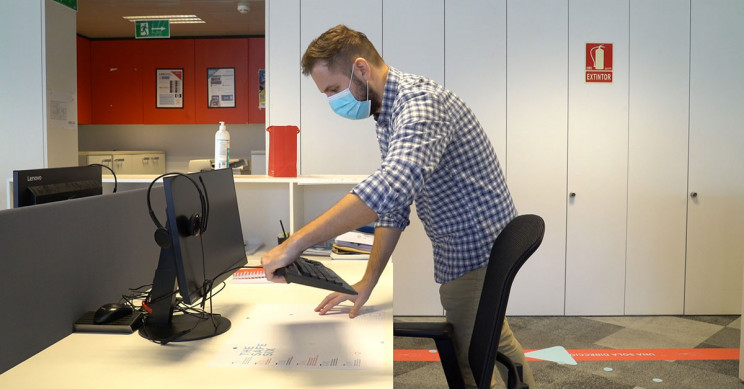The return to work in the midst of the de-escalation of the confinement imposed as a result of the health crisis has forced companies to adopt a series of measures to safeguard the safety and health of their employees, as well as to preserve public health.
The law firm Ashurst has prepared a very practical guide with all the questions and answers about the return to work, here we share the ones that we think most relevant to you.
With the public information currently available, we know that the most vulnerable people to COVID-19 are diabetics, people with cardiovascular disease, with chronic liver disease, chronic lung disease, chronic kidney disease, chronic neurological or neuromuscular diseases, immunodeficiency and oncological diseases in active treatment.
On this, it is pertinent to ask the following question:
Should particularly vulnerable people return to the workplace?
Whenever possible, it is recommended to work from home. If this is not possible, the Occupational Risk Prevention Service will be informed and a report will be drawn up on the prevention measures to be adopted and the possibility of adapting the workplace or relocating the employee to another job without risk of exposure.
If none of the above options are possible, the Occupational Risk Prevention Service should prepare a report for the Public Health Service recommending the isolation of the employee. The Public Health Service must determine whether the employee should remain in isolation and, if so, will grant him or her a temporary disability situation similar to an accident at work.
What requirements must companies meet before returning to the workplace?
Companies must ensure that the workplace has the necessary materials to comply with hygiene and interpersonal distance recommendations. In addition, they should establish waste management protocols and establish specific areas for the disposal of personal protective equipment in case of contamination.
Likewise, the company must control and monitor the correct implementation of hygiene and safety measures within the company, with special emphasis on the protection measures that must be taken for those employees who, due to their own personal characteristics or physical, mental or sensory disabilities are particularly sensitive to certain risks arising from work.
What hygiene and health recommendations should companies adopt once their employees return to their workplaces?
This involves reinforcing the cleanliness of frequently touched surfaces, bathroom surfaces and toilets and providing staff with the necessary hygiene products. In general, it is necessary to maintain an adequate supply of soap, hydroalcoholic solution and tissues.
It is also necessary to place informational posters on hand washing and respiratory hygiene (how to cough and sneeze) and remind employees of instructions on the correct use and maintenance of all PPE (especially gloves and masks when it is not possible to maintain a safe interpersonal distance).
At each shift change it is necessary to clean the workspace where an employee has been.
The workplace must maintain a temperature between 23º C and 26º C and it is necessary to reinforce the cleanliness of air filters and increase the level of ventilation of air conditioning systems to renew the air more regularly.
Staggered access to the workplace and staggered use of changing rooms must be allowed, and pedal dumpsters must be provided. The company must enable goods reception areas that respect safety distances and must place methacrylate protective screens for counters and service areas for concurrent companies, etc.
Can the employer take the temperature of his employees before they enter the workplace?
Given the exceptional circumstances, taking the temperature is an ideal measure to detect possible infections and safeguard the safety and health of other employees attending the workplace, as well as third parties with whom staff can interact. However, it must be limited to the detection of a possible contagion and must be carried out with approved equipment and by prevention personnel.
What if an employee has symptoms related to covid-19?
If an employee has symptoms related to covid-19 (cough, fever, shortness of breath, etc.) or has been in close contact or in a shared space without maintaining interpersonal distance with a person affected by COVID-19, they will refrain from attending work until it is confirmed that there is no risk of contagion. Therefore, it is advisable to establish protocols in case an employee presents symptoms, to protect him and the rest of the staff.
Is the employee in preventive quarantine or affected by covid-19 required to inform the company of this?
The general rule is that an employee is not required to report the reason for his medical leave to the company. However, as the Spanish Data Protection Agency points out in its Report on data processing in relation to COVID-19, in this case, public health takes precedence over the right to privacy of employees, so the employee must inform the employer in case of suspicion of having the virus , to safeguard not only their own health, but also that of other employees in the workplace, so that appropriate measures can be taken.
What happens if an employee refuses to go to the workplace for fear of contagion?
Bearing in mind that working from home should be understood as a health prevention measure, in those sectors where it is possible to continue working remotely and it is not necessary to attend the workplace or travel to continue the activity, the recommendation should be, whenever possible, that the employee work from home.
However, if it is mandatory for the worker to go to his place of work, he cannot refuse and could be subject to a sanction, unless the employee has a recommendation from the health authorities.
Source: www.idealista.com/news

